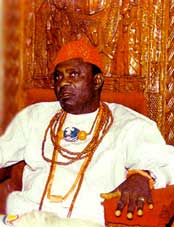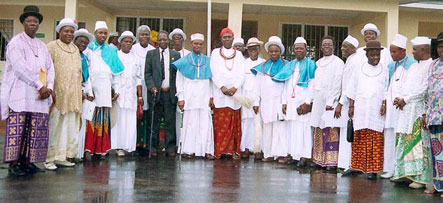
HRH Okpara I (JP)
The Ovie of Agbon |
THE KINGDOM
Agbon Kingdom (clan) covers
about 375 square kilometers. The land is bounded in the north by Ethiope
East Local Government Area, made of fellow Urhobo communities, and
Orhiowon Local Government Area in
neighbouring Edo State, with Benin
communities. On the east, it is bounded by Abraka Clan and Orogun Clan,
Ujode River, and Ekrerhavwe, all of which are Urhobo communities in
Ughelli North Local Government Area. To Agbon's west lie other Urhobo
communities of Agbarho a kingdom within Ughelli North Local Government
Area, Orerokpe and Aghalokpe of Okpe Local Government Area.
NATURAL RESOURCES
Agbon is naturally blessed with very fertile land with well developed
agricultural activities. Food, mostly yam, plantain and cassava, are
successfully farmed. In addition, cash crops like palm produce and
rubber plantations are well developed.
In addition to all these, Agbon has many
oil fields within its territory. The Erhorike Oil wells are
considered to be among the shallowest in the world.
Apart from these, results of some
seismic/geological investigations undertaken in the area have revealed
large prospects of additional oil deposits within Agbon territory.

Agbon Chiefs in a group photograph with the Ovie
of Agbon (center/maroon wrapper) |
POPULATION
Dating back to Nigeria's 1963 Census, Agbon has been ranked as the
second most populous cultural unit in Urhoboland, coming only after
Okpe. Today, using scientific projection with the 1963 population
figure as a base, we believe the Kingdom now has a much greater
population and most certainly retains its second ranking among Urhobo
cultural units.
HUMAN RESOURCES
The greatest gift of Agbon Kingdom is its people. Its hardworking
citizens have been in the forefront of development in Urhoboland and
beyond. It is on record that Agbon produced the first Principal of
Urhobo College, M.G. Ejaife. He later served as Urhobo's first Senator.
Agbon also produced the first Chief of Staff of the Nigeria Army, Major
General David A. Ejoor, as well as the first Urhobo Chief Justice of the
Federal Republic of Nigeria, Justice Ayo Irikefe. It is from this
portion of Urhoboland that Nigeria had its first Commissioner for
Labor, Chief T.E.A. Salubi, during the colonial administration.
Many Agbon sons fought
honourably in the Nigerian Civil
War. A prominent example was the late Major Nicholas Smart Otite, who
was a squad mate of General Babangida, General Abacha, General Useni,
General Hanadu, and Major General Nasko. Smart Otite died at the Onitsha
theatre of the war.
COMPOSITION OF AGBON KINGDOM
Agbon Kingdom is made up of the following sub-Kingdoms which are named
after the descendants of the children of Agbon:
(1) OKPARA (FIRST SON)
(2) KOKORI (SECOND SON)
(3) EKU (THIRD SON)
(4) ORHOAKPOR (ORHOKPOR – FOURTH
SON)
(5) IGUN
(6) OVU (DESCENDANT OF OKPARA)
In the course of time,
Igun has become part and parcel of the Agbon Kingdom. It is on record
that Igun migrated from the descendants of Ohwoyovwe in Ewu and settled
in Agbon Kingdom. The residents of Igun were later adopted by the Agbon
people.
Until the nineteen twenties, Ovu was
part Okpara. As a result of the high rate at which the population of Ovu
grew, they moved from Eregbe Quarters of Okpara to their present
location, where they found fertile land for their farming occupation.
Up till date the Ovu people maintain
cultural ties with the people of Okpara. These ties were developed
before their settlement in their present location.
Towns and villages of
Agbon Kingdom
(1) Isiokolo (2) Ekrebuo (3) Kokori Inland (4) Erhomeghwu (5) Okuidjerhe
(6) Samagidi (7) Egbogho (8) Urhwokpe (9) Ekraka (10) Erhonaka (11)
Erhorike (12) Okpara Inland (13) Okurutuyo (14) Okurekpagha (15) Unumane
(16) Okoradaode (17) Okurufor (18) Okururhujevwe (19) Umiaghwa (20)
Okurihohi (21) Okwibada (22) Erhokori (23) Orhuakpor (24) Ekrudu (25)
Okwukpokpo (26) Okureghwro (27) Eku (28) Igun (29) Otumara (30) Okpara
W/S (31) Okorogba (32) Okurekpo (33) Okredafe (34) Oviorie (35) Ovu
Inland (36) Okuemeka (37) Okurekpagha (38) Okuogbamu (39) Ovwere (40)
Urhobo (41) Okumodje (42) Obadjere (43) Ekpan (44) Igwevwore (45)
Okwokpokpo
(46) Ekusioro (47) Okurobi (48) Okuronika (49) Okuighele (50) Ekirugbo.
CONCLUSION
Agbon Kingdom has been a pace setter in the whole of Urhobo land. From
producing the first President of Urhobo Progress Union – in the person
of Chief Omohwovo -- it later gave Urhobo two other Presidents General:
Chief John A. Okpodu, who succeeded Chief Mukoro Mowoe, and Chief T. E.
A. Salubi. It has contributed much to the educational development of
Urhoboland and boasts of having one of the heaviest concentrations of
graduates, medical doctors, and professors -- in all of Africa.
|

